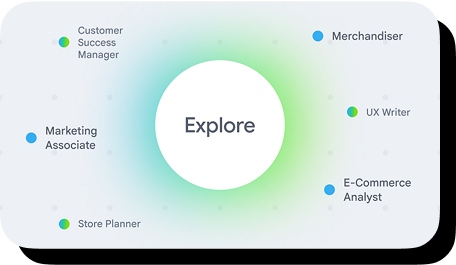
What is digital marketing?

Understanding digital marketing
Digital marketing refers to the strategies and tactics that businesses use to engage with their target audiences through online platforms. This includes activities like paid advertising, social media posts, search engine optimization, and email campaigns, all of which can be used to help drive engagement and boost revenue for a business. Today, it’s a highly dynamic field that couples creative thinking with data-driven insights, and the advent of AI offers a glimpse into marketing’s bright future.
How digital marketing works
Digital marketing is a big field that encompasses many functions, from email campaigns to website creation. At its core, however, it's about using online platforms to connect businesses with their target audiences. Essentially, there are four stages to digital marketing strategy:
- Strategic planning and audience definition: Digital marketers begin by defining clear goals, such as increasing website traffic or converting more leads into customers (ie, improving conversion rates). They then use research and analysis to identify and understand their target audience's behaviors and needs. From there, they can understand what needs to be done to reach their audiences and achieve their business goals.
- Content creation and channel activation: In this stage, marketers create and distribute digital content (e.g., blog posts, videos, social media updates, ad copy) to help engage their target audience. This content is strategically deployed across relevant digital channels like social media platforms, email marketing lists, search engines, and paid advertising networks.
- Performance monitoring and data analysis: Marketers use analytics tools like Google Analytics, social media insights, and other dashboards to track campaign performance in real-time. By analyzing metrics like website traffic, engagement rates, click-through rates, and more, marketers can start seeing what's performing effectively and where improvements are needed.
- Iteration and conversion rate optimization (CRO): This final stage is all about continuous improvement. Marketers use the insights they've gathered from analyzing data to fine-tune their campaigns. They might try different tests, adjust their targeting, or tweak other aspects of the campaign, all with the goal of getting better results and more conversions.
You may notice that digital marketing isn't just a one-time effort, but a continuous, data-driven process. Consistent effort and iteration across all four stages can help businesses effectively adapt to online trends and continuously improve how they connect with their target audience.
Types of digital marketing channels
One of the first things you’ll learn as part of any digital marketing education is how to use different marketing channels to achieve your goals. Each one has a specific character and purpose. For digital marketers, some of the channels include:
- Search: Using search engines like Google, marketers can reach potential customers through two main tactics: Search Engine Optimization (SEO) and Search Engine Marketing (SEM). While SEO focuses on improving organic (unpaid) ranking and visibility within search results, SEM involves paid advertising to get prime placement on a search engine results page (SERP). It’s a little like trying to get your store onto the busiest street in town — you can optimize your location to attract natural foot traffic (SEO) or pay for prime advertising space in high-traffic areas (SEM).
- Social media: Social media platforms offer businesses a busy crossroads of internet traffic where they can connect directly to customers. A strong social media presence can help marketers increase brand awareness, drive traffic, and foster customer loyalty.
- Email: Though email might seem less flashy than social media or traditional advertising, it remains an effective marketing channel for reaching and engaging customers. By sending targeted, sometimes personalized messages, skilled email marketers can build relationships, promote products, and more consistently drive traffic and sales.
- Affiliates and influencers: These channels involve partnerships with external partners who promote products or services through their own platforms. Affiliates typically earn a commission for sales or leads they generate, making their focus primarily on direct conversions. Influencers, on the other hand, leverage their credibility and audience reach to authentically integrate and recommend products. Influencers are often compensated for brand awareness and engagement rather than solely direct sales.
Digital marketing in the customer journey
Digital marketing is crucial for guiding the customer journey, touching every stage from initial awareness to post-purchase engagement. Let's consider how various digital marketing channels come together through one hypothetical customer's experience:
- Awareness: Our hypothetical customer, Sarah, is searching for a new pair of running shoes. She types "best running shoes" into a search engine and sees an ad for a sports brand at the top of the search results, thanks to the company’s SEM tactics. Intrigued, she clicks on the ad.
- Consideration: Sarah lands on the company’s website, where she finds a lot of valuable information created by the company’s content marketers. She takes a look at the product images and descriptions, customer reviews, and a blog post about choosing the right running shoes for your foot type. She spends some time browsing the site, comparing different options.
- Decision: Sarah is impressed with what she's seen, but she’s not quite ready to commit. Instead, she decides to sign up for the company’s email newsletter to stay informed about new products and special offers. As she browses the web over the next couple of days, she sees more ads on her feed from that brand. This process of showing targeted ads to users who’ve already visited a company’s website or interacted with their content is called “remarketing” or “retargeting,” and gets set up by the company’s paid advertising team. A few days later, the company’s email marketing team sends Sarah an automated, personalized email with a discount code for her first purchase.
- Purchase: With the discount code in hand, Sarah returns to the website and makes her purchase. After receiving her new shoes, she likes them so much that she takes a picture to post on social media, where the brand’s social media marketing team likes and comments on her posts.
- Loyalty: Even after buying, Sarah continues to receive helpful content from the brand, like tips on her running form, invitations to local events, and sneak peeks at upcoming releases. This extra effort makes her feel more connected and more likely to stick with the brand for future purchases.
Metrics for digital marketing
Digital marketing is a data-driven practice, with success often measured in numbers. Marketers and data analysts use a variety of metrics, including key performance indicators (KPIs), to gauge how effective their campaigns are. Common KPIs include:
- Click-through rates (CTR): CTR measures how many people click on an ad or link compared to how many times it was shown (impressions). It's crucial for understanding how relevant and appealing your online content is to your audience.
- Website traffic: The number of visitors to a website is a fundamental metric of online success. While increasing website traffic is unlikely to be the end-goal of a marketing campaign, it indicates the reach and visibility of a brand's online presence.
- Conversion rates: A conversion is a desired action a visitor takes on a website, like making a purchase or signing up for an email newsletter. Conversion rates tell you the percentage of visitors who complete these actions, showing how effective a website is at achieving its goals.
- Cost per acquisition (CPA): For most businesses, the bottom line is the ultimate metric. CPA measures the cost of acquiring a new customer through digital marketing efforts by dividing marketing costs by the number of new customers acquired, helping marketers assess the efficiency of their spending.
- Return on ad spend (ROAS): This metric specifically measures revenue generated relative to advertising costs by dividing revenue by advertising spend. While CPA considers all marketing costs, ROAS focuses solely on advertising spend to help marketers evaluate their campaign’s profitability and scalability.
These metrics provide valuable insights into the effectiveness of digital marketing strategies. By consistently monitoring and analyzing KPIs like the ones above, businesses can make informed decisions, optimize their campaigns, and ensure their marketing activities are directly contributing to their overall business objectives in a cost-effective way.
The future of digital marketing
The evolution of digital platforms, advanced analytics, and AI-powered tools has transformed the marketing landscape and is redefining successful strategies. Consequently, savvy digital marketers have learned to adapt quickly while continuously building their skills, especially as new skills open up new opportunities in established fields.
AI, for example, is reshaping how campaigns are developed and optimized. Mastering AI fundamentals and effective prompting is now a part of many digital marketing strategy playbooks. As businesses increasingly rely on these advancements, marketers who adopt and leverage emerging technologies are likely to become increasingly important.
Learn more
What is digital marketing? As you see, it’s more than a career path — it’s a dynamic, rapidly-evolving field brimming with opportunities to innovate, connect, and grow. As technology advances and consumer behaviors change, the potential for innovative and effective campaigns is limitless. By staying curious, embracing change, and continually sharpening your skills, you can not only keep pace with this dynamic field but also help actively shape its future. The Google Digital Marketing & E-commerce Certificate offers hands-on training to build the job-ready skills employers need today.






